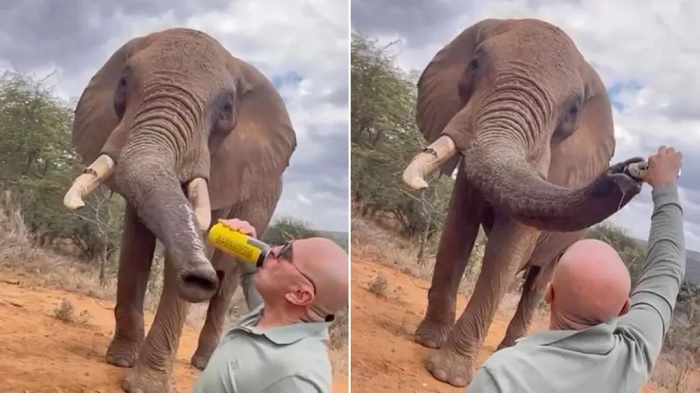- A Spanish tourist filmed himself pouring beer into an elephant’s trunk at Ol Jogi Conservancy.
- The elephant, believed to be Bupa, is a well-known rescued bull with a damaged tusk.
- The act sparked outrage and led to investigations by Kenya Wildlife Service.
- Conservationists condemned the stunt as dangerous and misleading.
- The same tourist also violated rules at Ol Pejeta Conservancy by feeding a rhino.
- The incident follows recent tourist misconduct at Maasai Mara during the wildebeest migration.
- Kenya’s tourism ministry has pledged stricter enforcement and better visitor education.
Kenya’s wildlife community is reeling after a Spanish tourist posted videos of himself pouring beer into the trunk of a well-known elephant at Ol Jogi Conservancy in Laikipia County.
The man, who goes by the handle “Skydive_Kenya” on social media, was seen sipping Tusker beer before tipping the rest into the elephant’s trunk. He captioned the now-deleted clip: “Just a tusker with a tusked friend.”
The elephant in question is believed to be Bupa, a gentle bull rescued from a mass cull in Zimbabwe in 1989 and relocated to Ol Jogi. Staff at the sanctuary expressed shock, saying the act violated strict conservation rules. “We don’t even allow people to go near the elephants,” one employee said.
The Kenya Wildlife Service (KWS) has launched an investigation, and conservationists have condemned the stunt as reckless and misleading. Dr Winnie Kiiru, a leading elephant biologist, warned that such behavior endangers both humans and animals, and falsely suggests that wild elephants are safe to approach.
The same tourist also posted footage from Ol Pejeta Conservancy, where he was seen feeding a rhino — another violation of park rules. Officials confirmed the rhino was from their reserve and criticized the tourist for treating wildlife like pets.
The incident follows another viral controversy in Kenya, where tourists were filmed obstructing migrating wildebeests at Maasai Mara, prompting the tourism ministry to announce stricter enforcement of park regulations.
As calls for accountability grow, the spotlight is once again on how social media stunts are undermining conservation efforts and endangering Kenya’s most iconic wildlife.



